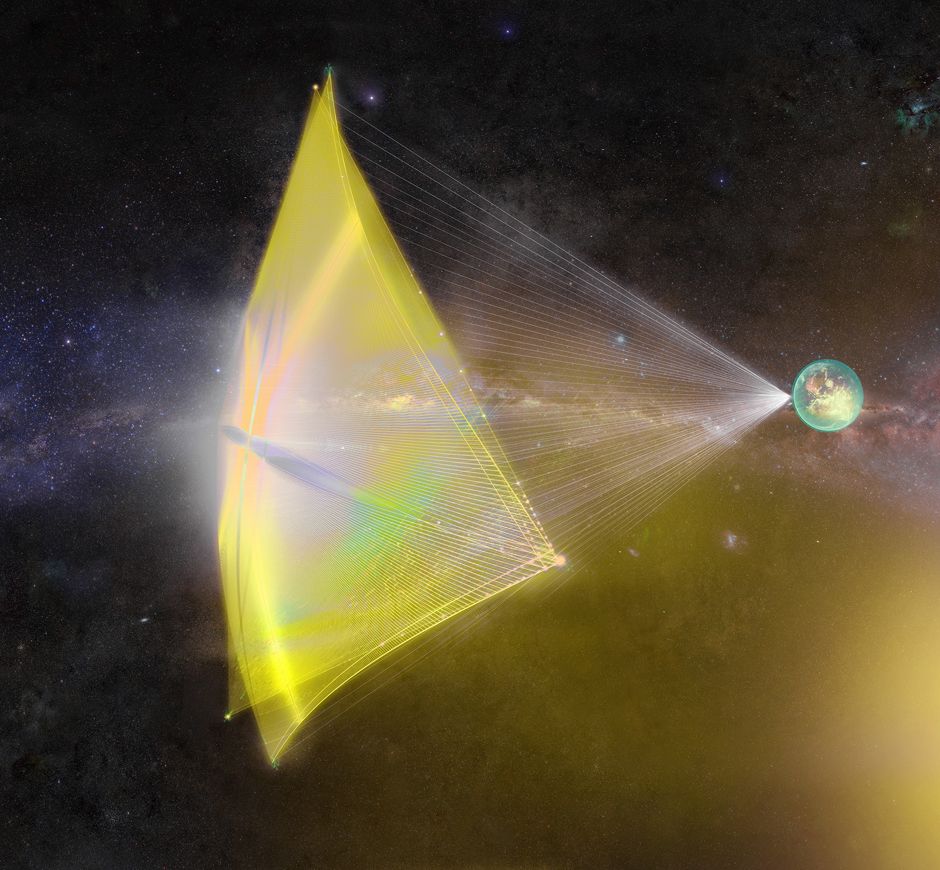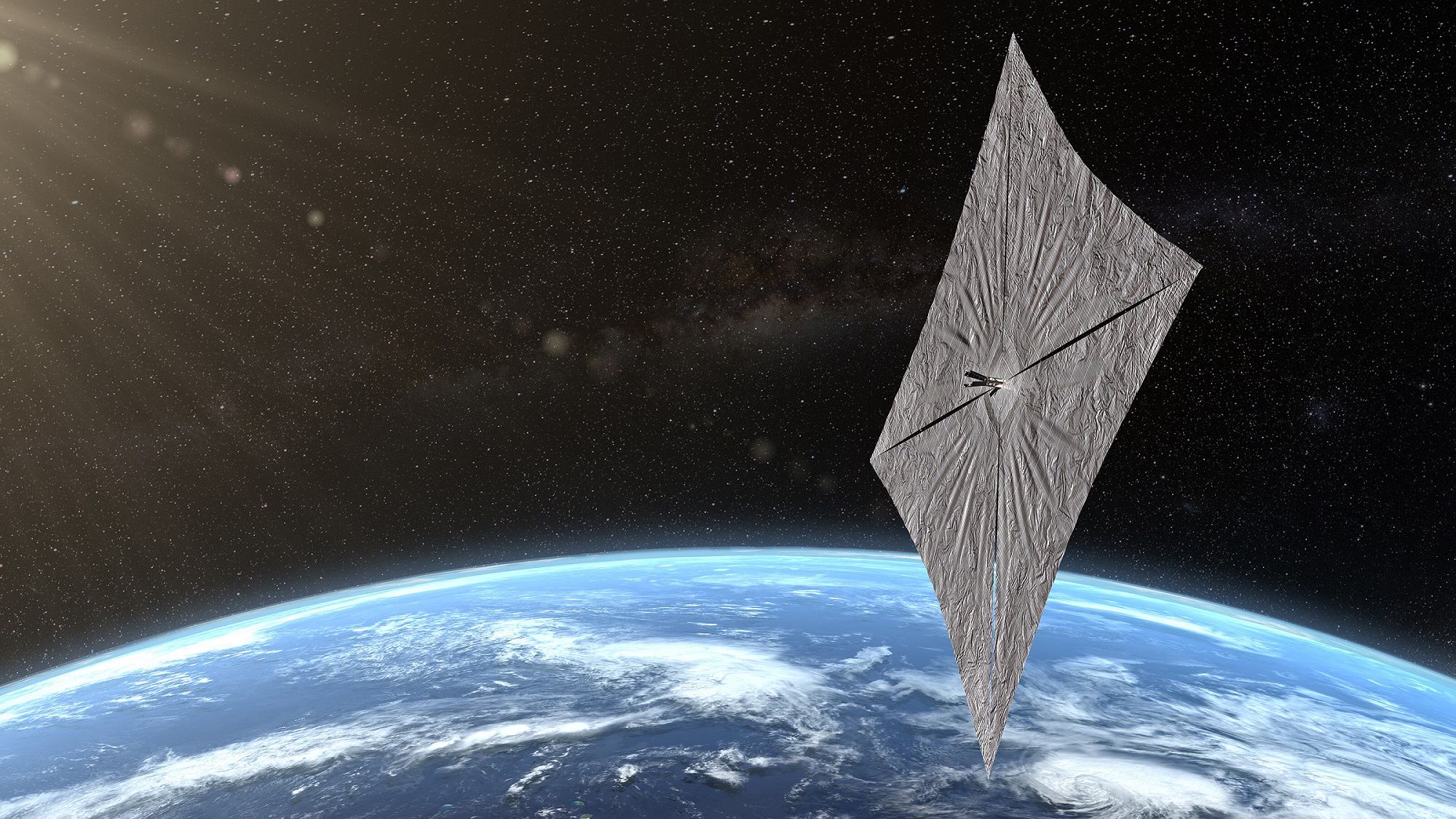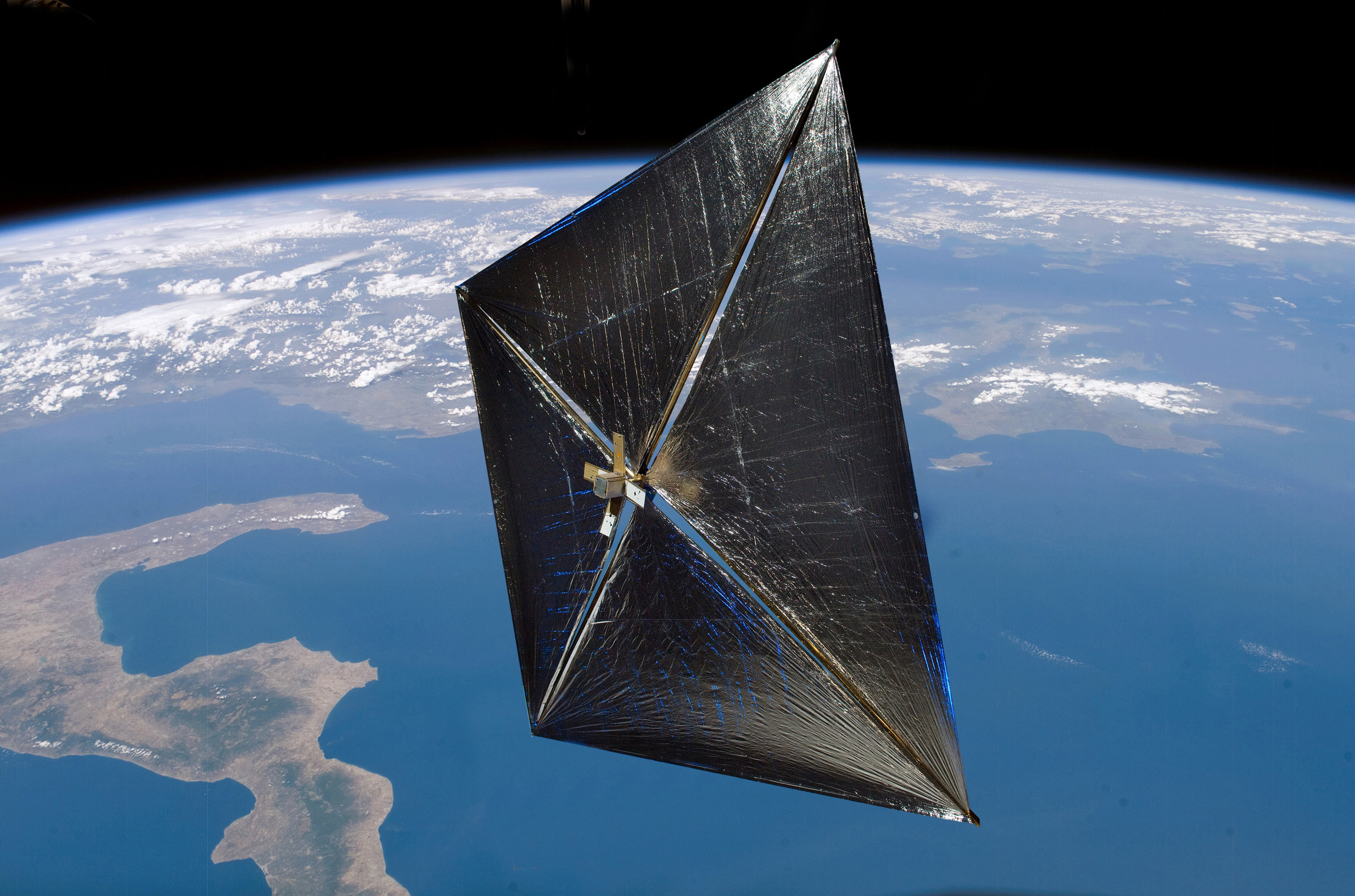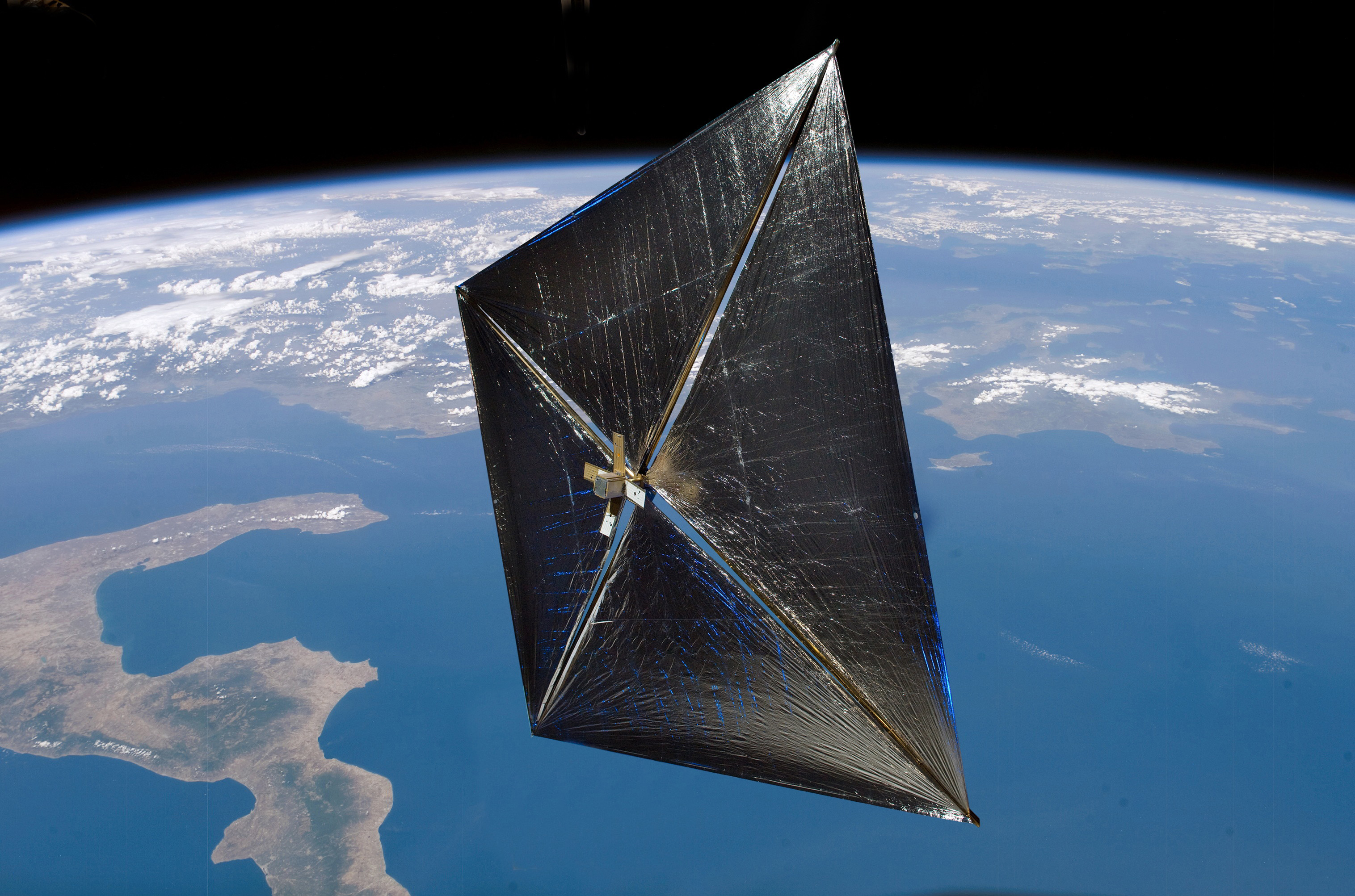Solar sails have been receiving a lot of attention lately. In part that is due to a series of high profile missions that have successfully proven the concept. It’s also in part due to the high profile Breakthrough Starshot project, which is designing a solar sail powered mission to reach Alpha Centauri. But this versatile third propulsion system isn’t only useful for far flung adventures – it has advantages closer to home as well. A new paper by engineers at UCLA defines what those advantages are, and how we might be able to best utilize them.
Continue reading “Forget About Interstellar Flights. Tiny Light Sails Could be Used to Explore the Solar System Today”A Cool Idea to Catch Up With an Interstellar Visitor

Poor, dim-witted humanity.
We used to think we were the center of everything. That wasn’t that long ago, and even though we’ve made tremendous advancements in our understanding of our situation here in space, we still have huge blind spots.
For one, we’re only now waking up to the reality of interstellar objects passing through our Solar System.
Continue reading “A Cool Idea to Catch Up With an Interstellar Visitor”LightSail 2 is Sending Home New Pictures of Earth

LightSail 2, the brainchild of The Planetary Society, has gifted us two new gorgeous images of Earth. The small spacecraft is currently in orbit at about 720 km, and the LightSail 2 mission team is putting it through its paces in preparation for solar sail deployment sometime on or after Sunday, July 21st.
Continue reading “LightSail 2 is Sending Home New Pictures of Earth”LightSail 2 Mission is Going Strong and Sending Mission Info Home!
On June 25th, 2019, The Planetary Society‘s
Since reaching orbit, the LightSail 2 has been indicated that it is in good working order, as indicated by the Mission Control Dashboard recently introduced by The Planetary Society. In addition to establishing two-way communications with mission controllers and passing a battery of checkouts, the spacecraft also took its first pictures of Earth (and some selfies for good measure).
Continue reading “LightSail 2 Mission is Going Strong and Sending Mission Info Home!”Weekly Space Hangout – June 12, 2015: Astronomy in Chile Educator Ambassadors Program
Host: Fraser Cain (@fcain)
Special Guest: This week we welcome Astronomy in Chile Educator Ambassadors Program Participants:
Michael Prokosch (Seeing Stars Blog, MikeProkosch@shsuobservatory)
Tim Spuck ([email protected])
Brian Koberlein (@briankoberlein / briankoberlein.com)
Vivian White ([email protected]).
Guests:
Jolene Creighton (@jolene723 / fromquarkstoquasars.com)
Brian Koberlein (@briankoberlein / briankoberlein.com)
Morgan Rehnberg (cosmicchatter.org / @MorganRehnberg )
Alessondra Springmann (@sondy)
Continue reading “Weekly Space Hangout – June 12, 2015: Astronomy in Chile Educator Ambassadors Program”
The Planetary Society’s Solar Sail Will Hitch a Ride to Space on a Falcon Heavy
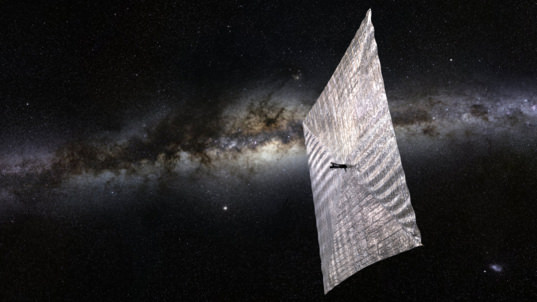
In a live webcast, The Planetary Society CEO Bill Nye announced that its long-awaited LightSail solar sail mission will launch to Earth orbit on a SpaceX Falcon Heavy, currently scheduled for an April 2016 liftoff. LightSail-1 and its parent satellite, Prox-1, will be on the same launch vehicle as the U.S. Air Force’s Space Test Program 2 (STP-2) mission. If successful, it will be the first CubeSat to demonstrate controlled solar sailing.
“It’s fantastic that at last we have a launch date for this pioneering mission,” said Nye.
The Planetary Society has raised over $4 million for the mission, but according to Jason Davis from TPS, the launch costs will be paid by the USAF and Georgia Institute of Technology, which developed the Prox-1, a technology demonstration for using small satellites to autonomously inspect other spacecraft.
LightSail will go to an orbit about 720 km above Earth, stored inside the Prox-1, which was developed by the Georgia Institute of Technology to demonstrate new technologies enabling two spacecraft to work in close proximity. After ejecting LightSail, the largely student-built Prox-1 will track and image LightSail, including the sail deployment.
Here’s the LightSail-1 mission trailer:
According to TPS, cubesats utilize a standard design based on 10-centimeter (about 4-inch) cubes. LightSail is three cubes, or just 30 centimeters long. Tucked inside this tiny package are four ultra-thin Mylar sails that will be deployed a few weeks after orbital insertion. The reflective wings will expand to 32 square meters (344 square feet), making LightSail easily visible to naked eye observers on Earth.
There might be a test flight of a prototype LightSail-A on a smaller rocket, perhaps in 2015. This flight will only reach low earth orbit, where the atmosphere is too thick for a solar sail to function, but it will allow the LightSail team to check the operation of vital systems in the extreme environment of space. That team includes faculty and students at California Polytechnic State University in San Luis Obispo.
While the test flight would only stay in orbit for a week or so, the 2016 main LightSail mission should remain in orbit for several years.
Solar sails are not new, and have already been launched and deployed in space, but have had limited success. The Japanese Ikaros satellite unfurled a 14-meter solar sail back in 2010. NASA launched the Nanosail-D spacecraft in 2011 and is expected to launch the Sunjammer solar sail in early 2015.
A spacecraft propelled by a solar sail uses the sail to capture photons emitted from the Sun. Over time, the buildup of the solar photons provides enough thrust for a small spacecraft to travel in space. Solar sails could one day be an alternative to conventional propellant-based spacecraft.
The Planetary Society has a long history of solar sail activity. In June 2005, the Society attempted to launch Cosmos 1, which would have been the first solar sail in space. The failure of a Russian booster doomed that effort, but then proceeded with fundraising for the Lightsail mission.
Find out more details about the LightSail mission at the Planetary Society, and here’s Fraser with more details about solar sails:
What Is A Solar Sail?
I’m Fraser Cain, and I’m a sailor. Well, okay, I’ve got a sailboat that I take out on the water when its warm and the weather’s nice here on Vancouver Island. I think it’s one of the reasons I absolutely love the idea of a solar sail.
Here’s how they work: Light is made up of photons. Even though they have no mass at rest, they have momentum when they’re moving, well, light speed. When they reflect off a surface, like a mirror or a shiny piece of metal, they impart some of this momentum to that surface. This effect is negligible here on Earth, but out in space, with forces perfectly in balance, that additional momentum can really add up.
A spacecraft flying to Mars gets pushed off course by several thousand kilometers because of light pressure from the Sun.If mission planners didn’t compensate for this drift, their spacecraft would miss the planet, or even worse, crash into it. Even though the total amount of pressure per square meter on a solar sail is minuscule, it’s constantly streaming from the Sun, and it’s totally free….And propulsion that you don’t have to carry with you is the best kind there is.
This is more than just an idea. Solar sails have already been launched and deployed in space. The Japanese Ikaros satellite unfurled a 14-meter solar sail back in 2010. NASA launched its own Nanosail-D spacecraft in 2011. An even bigger solar sail, the Sunjammer, is planned for launch in 2014. The Planetary Society is working on a solar sail project as well.
The closer to the Sun you are, the better they work. In fact, a solar sail would be an ideal vehicle to explore the regions of Mercury and Venus, since they receive so much radiation. But you’re probably wondering how a solar sail could get down to those planets because light is streaming from the Sun in all directions. It’s all about raising and lowering your orbit. If you want to raise your orbit around an object, all you have to do is speed up. And if you want to lower your orbit, you just need to slow down.
A solar sail launched from Earth would start out with the same orbital velocity around the Sun as the Earth. To get into a higher orbit, it tilts the sail so that the light from the Sun speeds it up. And to get into a lower orbit, it tilts in the opposite direction, and the light from the Sun acts like a brake.
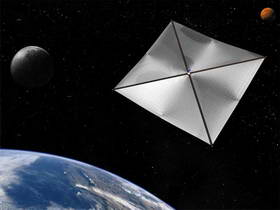
A solar sail might even be the ideal spacecraft to make the journey to another star. An interstellar solar sail could lower its orbit so that it’s just above the surface of the Sun. Then, it would unfurl the full sail and capture the most possible photons. A series of powerful laser beams would then target the sail and increase its velocity to a significant fraction of the speed of light.
Of course, you’d need a solar sail thousands of kilometers across, made of a material thinner than a human hair, and lasers putting out more energy than all of humanity. The idea is still intriguing, even though it’s well outside our current technology. Once this technology gets better tested, we’ll to see many more missions employ solar sails as part of their propulsion system.
See NanoSail-D in Orbit, Win a Prize!
Looking for the orbiting NanoSail-D just got more exciting! NASA and Spaceweather.com have teamed up to offer prizes for the best amateur astronomy image of the now-orbiting and unfurled NanoSail-D solar sail. NanoSail-D unfurled the first 100-square-foot solar sail in low-Earth orbit on Jan. 20.
To encourage observations of NanoSail-D, Spaceweather.com is offering prizes for the best images of this historic, pioneering spacecraft in the amounts of $500 (grand prize), $300 (first prize) and $100
(second prize).
The contest is open to all types of images, including, but not limited to, telescopic captures of the sail to simple wide-field camera shots of solar sail flares. If NanoSail-D is in the field of view, the image is eligible for judging.
The solar sail is about the size of a large tent. It will be observable for approximately 70 to 120 days before it enters the atmosphere and disintegrates. The contest continues until NanoSail-D re-enters Earth’s atmosphere.
NanoSail-D will be a target of interest to both novice and veteran sky watchers. Experienced astrophotographers will want to take the first-ever telescopic pictures of a solar sail unfurled in space.
Backyard stargazers, meanwhile, will marvel at the solar sail flares — brief but intense flashes of light caused by sunlight glinting harmlessly from the surface of the sail.
NanoSail-D could be five to 10 times as bright as the planet Venus, especially later in the mission when the sail descends to lower orbits. The NanoSail-D satellite was jointly designed and built by NASA engineers from the agency’s Marshall Space Flight Center in Huntsville, Ala., and NASA’s Ames Research Center in Moffett Field, Calif.
To learn more about the NanoSail-D imaging challenge and contest rules, satellite tracking predictions and sighting times, visit this page about NanoSail-D. (not much info there yet as I write this….)
or see the NanoSail-D website for more info about the solar sail mission.
It’s Alive! NanoSail-D Suddenly and Spontaneously Comes Back to Life
[/caption]
A small solar sail that was thought to be a lost cause has “spontaneously” come back to life. The NanoSail-D — a NASA-designed solar sail cubesat that launched in December but suddenly went silent without confirmation of its deployment — unexpectedly ejected from its host satellite on Wednesday, Jan. 19 at 11:30 a.m. EST. Engineers at Marshall Space Flight Center confirmed that the NanoSail-D nanosatellite ejected from Fast Affordable Scientific and Technology Satellite, FASTSAT, when they looked at onboard FASTSAT telemetry. The ejection of NanoSail-D also has been confirmed by ground-based satellite tracking.
Now NASA is asking for help from ham radio operators to listen for the signal to verify NanoSail-D is operating. And knowing the status of the solar sail is time critical.
“This is great news for our team. We’re anxious to hear the beacon which tells us that NanoSail-D is healthy and operating as planned,” said Dean Alhorn, NanoSail-D principal investigator and aerospace engineer at the Marshall Center. “The science team is hopeful to see that NanoSail-D is operational and will be able to unfurl its solar sail.”
If you are a ham operator, This information should be sent to the NanoSail-D dashboard at: http://nanosaild.engr.scu.edu/dashboard.htm. The NanoSail-D beacon signal can be found at 437.270 MHz. You can learn more at the MSFC’s Ham Radio Operator’s webpage.
NanoSail-D was designed to test the potential for solar sails in atmospheric braking. On December 6, 2010, it was schedule to eject from the FASTSAT, and initially it looked as though it did. But later, ground controllers were unable to confirm if the solar sail had ejected or deployed. Further analysis showed no evidence of NanoSail-D in low-Earth orbit, leading the team to believe NanoSail-D remained inside FASTSAT.
Now, with this latest news that the loaf-of-bread-sized satellite has ejected on its own, the NanoSail-D science team is hopeful the nanosatellite is healthy and can complete its solar sail mission. But the sequence of events are time critical.
After ejection, a timer within NanoSail-D begins a three-day countdown as the satellite orbits the Earth. Once the timer reaches zero, four booms will quickly deploy and the NanoSail-D sail will start to unfold to a 100-square-foot polymer sail. Within five seconds the sail fully unfurls.
“We knew that the door opened and it was possible that NanoSail-D could eject on its own,” said Mark Boudreaux, FASTSAT project manager at the Marshall Center. “What a pleasant surprise this morning when our flight operations team confirmed that NanoSail-D is now a free flyer.”
If the deployment is successful, NanoSail-D will stay in low-Earth orbit between 70 and 120 days, depending on atmospheric conditions. NanoSail-D is designed to demonstrate deployment of a compact solar sail boom system that could lead to further development of this alternative solar sail propulsion technology and FASTSAT’s ability to eject a nano-satellite from a micro-satellite — while avoiding re-contact with the FASTSAT satellite bus.
Source: Marshall Space Flight Center
Nanosail-D Update: Things Look Grim
[/caption]
We reported the successful ejection of the Nanosail-D nanosatellite from the satellite that it was launched with earlier this week. Well, the most recent release from NASA states that things might have turned out otherwise. Not only has the sail potentially failed to deploy, it’s currently unclear if the nanosatellite was even ejected.
In NASA’s own words on the mission site:
At this time, it is not clear that NanoSail-D ejected from the Fast, Affordable, Science and Technology Satellite (FASTSAT) as originally stated on Monday, Dec. 6. At the time of ejection, spacecraft telemetry data showed a positive ejection as reflected by confirmation of several of the planned on orbit ejection sequence events. The FASTSAT spacecraft ejection system data was also indicative of an ejection event. NanoSail-D was scheduled to unfurl on Dec. 9 at 12:30 a.m., and deployment hasn’t been confirmed. The FASTSAT team is continuing to trouble shoot the inability to make contact with NanoSail-D. The FASTSAT microsatellite and all remaining five onboard experiments continue to operate as planned.
What a bummer. This is all we have to go on right now – we’ll keep you posted as the situation develops over the weekend.
Source: NASA press release

